- Scientific name: Salvelinus fontinalis
- Species of Greatest Conservation Need (MA State Wildlife Action Plan)
Description
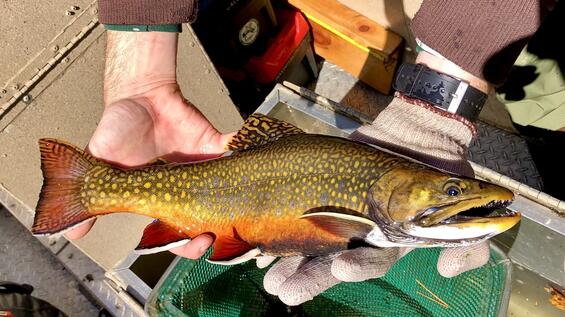
Eastern brook trout (Salvelinus fontinalis)
Brook trout are generally dark green or olive with a white belly. They show heavy dorsal vermiculations (worm-like markings), a varying amount of red and yellow spots, often with blue halos, along their flanks, and white leading edges on the pelvic and anal fins. They have a square or slightly forked tail. Body coloration intensifies during spawning and the lower flanks and belly of males become red or orange. Sea-run brook trout can often appear silvery or washed-out without the typical bold coloration of most brook trout. Adult brook trout in most Massachusetts streams typically reach 6-8 inches in length, but 10–12 inch specimens are possible in some populations, or even larger in certain circumstances. One- or two-year-old brook trout ranging from 3 to 6 inches are most numerous in many small streams, but individuals living in cold tailwaters or the spring-fed coastal streams with access to saltwater often grow considerably larger.
Life cycle and behavior
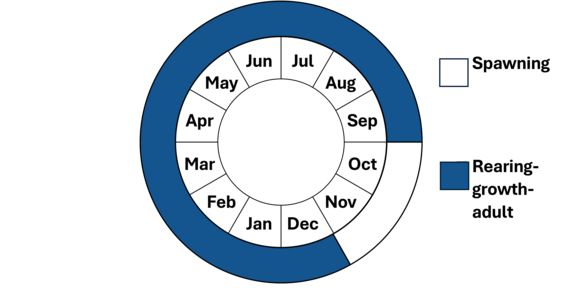
Brook trout spawn in October and November in both lakes and streams, although lake-spawning populations are considered to be extirpated in Massachusetts. There are, however, populations of brook trout along the coast where individuals can and often do leave the stream and spend part of their adult life in estuary habitats, returning to coastal streams to spawn. Female brook trout seek out areas of gravel substrate and groundwater upwelling where they use their tail to dig out a shallow depression in the substrate called a redd. Females lay their eggs in the redd, which are then immediately fertilized by one or more males. After the eggs are fertilized, the female covers the eggs and redd with gravel. Eggs hatch in approximately 3-4 months, after which the alevin stays nestled in the gravel and feeds off its attached yolk sac for a couple weeks before leaving the redd to begin finding its own food. Eggs and young receive no parental care.
The life span of brook trout in Massachusetts streams seldom exceeds three growing seasons. Brook trout are largely insectivorous, consuming a mix of aquatic and terrestrial invertebrates throughout their lives. However, other fish, or young of their own kind, can be an important component of their diet when available.
Distribution and abundance
Reproducing brook trout are found across Massachusetts. They are ubiquitous in western and much of central Massachusetts but occur only sporadically in the more heavily developed landscapes of eastern Massachusetts. Abundance varies year-to-year based on environmental conditions such as drought, inopportune flooding, heat waves, etc., but overall populations outside of eastern Massachusetts and developed landscapes tend to be fairly stable in the long term. Sea-run brook trout can be found in undammed coastal coldwater streams along the South Shore, Buzzards Bay, Cape Cod, and Martha’s Vineyard. Sea-run brook trout do exist in at least one coastal stream on the North Shore as well.
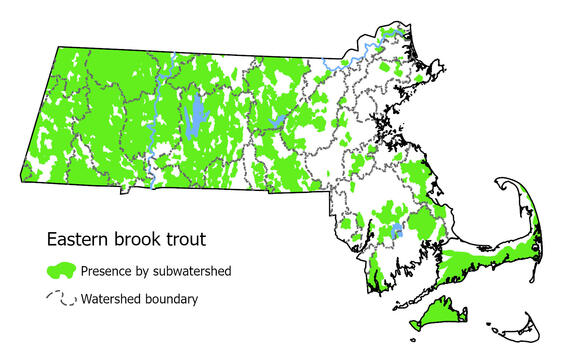
Data from 1999-2024 from annual surveys.
Habitat
Brook trout need cold, oxygenated water to survive, and areas of silt-free substrate in which to reproduce. In Massachusetts, brook trout inhabit a variety of stream and river habitats, from high- gradient mountain streams to low-gradient meadow brooks generally kept cool by riparian shade and groundwater input, tailwaters of rivers, and coastal spring-fed creeks. As mentioned above, brook trout globally are found in lakes, ponds, streams, and rivers, but in Massachusetts are considered a fluvial specialist (require flowing water for all portions of their life cycle) as there are no self-sustaining lake-only populations in Massachusetts.
Brook trout have more rigid temperature requirements than do brown trout, rainbow trout, or Atlantic salmon. They generally do not tolerate water temperatures exceeding 68°F for extended periods of time and their upper acute lethal temperature is approximately 75°F.
Healthy habitats are vital for supporting native wildlife and plants. Explore habitats and learn about conservation and restoration in Massachusetts.
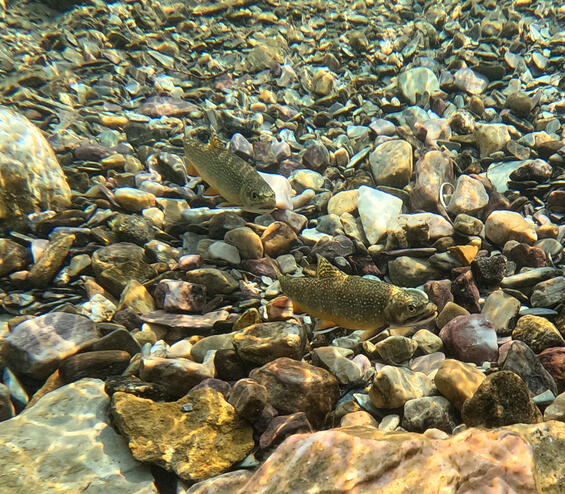
Ideal habitat for brook trout.
Threats
Any activities which decrease water quality, increase temperature, or cause siltation of spawning habitat are detrimental to this sensitive species. Some populations rely on areas of groundwater inputs as refuge areas during the warmest periods of the year; if the flow of such springs is altered or reduced, it may result in the loss of the population. Development, particularly the conversion of stream buffers to impervious surface, has been a primary threat to this species and will continue to be in the future. Climate change, with its warming temperatures, increased frequency of drought, and changes in precipitation patterns, will also determine distribution and persistence of brook trout in the future. More local threats include barriers to fish movement such as dams and culverts, loss of wetlands, riparian forest, and floodplain connectivity, and issues stemming from anthropogenic development such as stormwater runoff, groundwater withdrawal, and industrial and residential pollutants.
Conservation
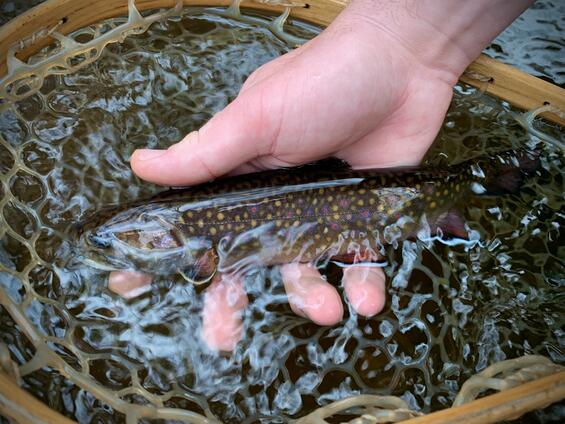
Eastern brook trout (Salvelinus fontinalis)
Because of their relative importance as a recreational angling species and their critical role as an indicator of intact coldwater habitats, the status and distribution of brook trout in Massachusetts are well known. Extensive work has been done over the years to gather data which have been used to develop a comprehensive Wild Trout Conservation Plan. This plan includes a compilation of all fish survey data from the past 25 years to summarize what is currently known about the abundance and distribution of wild brook trout across the Commonwealth. The plan also outlines several efforts which are to be used for conservation or restoration of brook trout populations.
References
Karsten E. Hartel, David B. Halliwell, and Alan E. Launer. Inland Fishes of Massachusetts. Lincoln, Massachusetts: Massachusetts Audubon Society, 2002
Contact
| Date published: | March 3, 2025 |
|---|